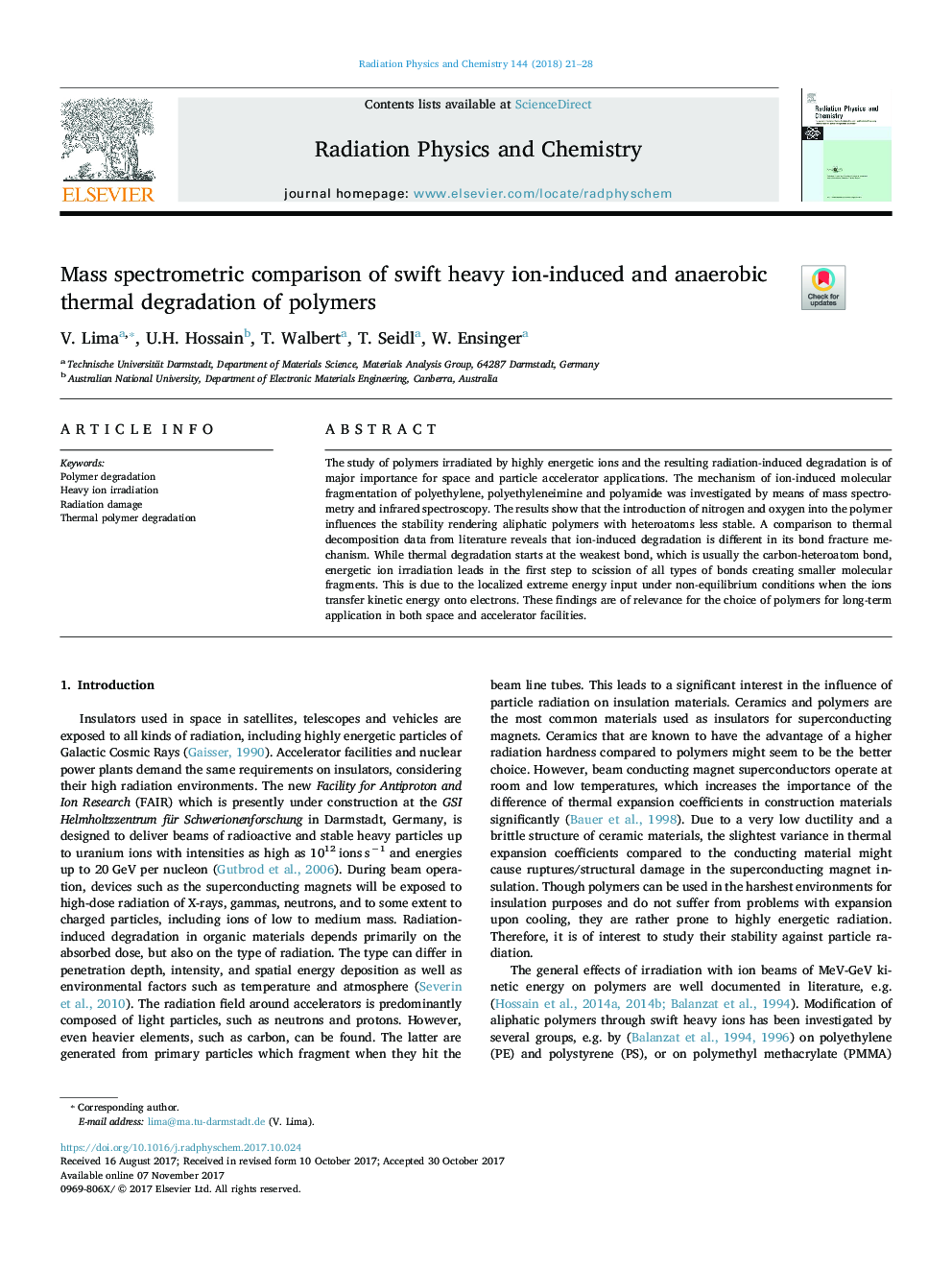| کد مقاله | کد نشریه | سال انتشار | مقاله انگلیسی | نسخه تمام متن |
|---|---|---|---|---|
| 8251723 | 1533480 | 2018 | 8 صفحه PDF | دانلود رایگان |
عنوان انگلیسی مقاله ISI
Mass spectrometric comparison of swift heavy ion-induced and anaerobic thermal degradation of polymers
ترجمه فارسی عنوان
مقیاس اسپکترومتریک مقایسه سریع تخریب های سنگین ناشی از یون و غیر هوازی پلیمرها
دانلود مقاله + سفارش ترجمه
دانلود مقاله ISI انگلیسی
رایگان برای ایرانیان
کلمات کلیدی
تخریب پلیمر، اشعه یون سنگین، آسیب تابشی، تخریب پلیمر حرارتی،
ترجمه چکیده
مطالعه پلیمرهای تابش شده توسط یونهای پر انرژی و تخریب ناشی از اشعه ایجاد شده از اهمیت زیادی برای کاربردهای فشرده و شتاب دهنده ذرات است. مکانیزم تجزیه مولکولی ناشی از یون پلی اتیلن، پلی اتیلنیمین و پلی آمید توسط طیف سنجی جرمی و طیف سنجی مادون قرمز مورد بررسی قرار گرفت. نتایج نشان می دهد که معرفی نیتروژن و اکسیژن به پلیمر بر پایداری پلیمرهای آلیفاتیک پایدار تاثیر می گذارد و هتروتوم ها کمتر پایدار هستند. مقایسه داده های تجزیه حرارتی از ادبیات نشان می دهد که تجزیه ناشی از یون در مکانیسم شکست شکست پیوند آن متفاوت است. در حالی که تضعیف حرارتی در ضخیم ترین پیوند، که معمولا پیوند کربن هیدروآموخته است، آغاز می شود، پرتو یون های پر انرژی در مرحله اول به تجزیه تمام انواع اوراق قرضه، ایجاد مولکول های کوچکتر منجر می شود. این به علت ورودی شدید انرژی موضعی در شرایط غیر تعادل است که یونها انرژی جنبشی را به الکترون منتقل می کنند. این یافته ها مربوط به انتخاب پلیمر ها برای کاربرد درازمدت در هر دو فضای و امکانات شتاب دهنده است.
موضوعات مرتبط
مهندسی و علوم پایه
فیزیک و نجوم
تشعشع
چکیده انگلیسی
The study of polymers irradiated by highly energetic ions and the resulting radiation-induced degradation is of major importance for space and particle accelerator applications. The mechanism of ion-induced molecular fragmentation of polyethylene, polyethyleneimine and polyamide was investigated by means of mass spectrometry and infrared spectroscopy. The results show that the introduction of nitrogen and oxygen into the polymer influences the stability rendering aliphatic polymers with heteroatoms less stable. A comparison to thermal decomposition data from literature reveals that ion-induced degradation is different in its bond fracture mechanism. While thermal degradation starts at the weakest bond, which is usually the carbon-heteroatom bond, energetic ion irradiation leads in the first step to scission of all types of bonds creating smaller molecular fragments. This is due to the localized extreme energy input under non-equilibrium conditions when the ions transfer kinetic energy onto electrons. These findings are of relevance for the choice of polymers for long-term application in both space and accelerator facilities.
ناشر
Database: Elsevier - ScienceDirect (ساینس دایرکت)
Journal: Radiation Physics and Chemistry - Volume 144, March 2018, Pages 21-28
Journal: Radiation Physics and Chemistry - Volume 144, March 2018, Pages 21-28
نویسندگان
V. Lima, U.H. Hossain, T. Walbert, T. Seidl, W. Ensinger,
